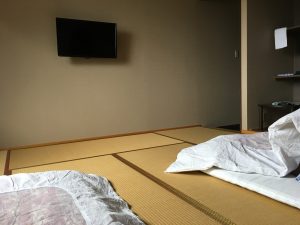The last section of the Kumano Koda is known as the most difficult, rated a 5/5 for the trekking. It is a climb and descent over the pass and is mostly in the forested mountains. The first section is called the dogiri-zaka, which can be directly translated as “body breaking slope” — it climbs almost 800 meters over about 5 km. For hundreds of years pilgrims have labored up and down this seemingly endless slope. Even the famous poet Fujiwara Teika (1162-1241) was at a loss for words after walking this section, stating “This route is very rough and difficult; it is impossible to describe precisely how tough it is”.
So we took the bus.
Actually 3 busses because you can’t get there from here — the mountains get in the way. (It’s sorta like the footwear necessary to navigate a ryokan. There are the indoor slippers, and the outdoor slippers and the toilet slippers, so you have to constantly change in and out of them, ensuring that you’re wearing the correct slippers at all time. Except on the tatami mats where you can’t wear any slippers. Or socks). So we took the 3 busses to get to the Seigantoji Temple and Nachi Waterfall. (I’ve become very adept at reading Japanese bus signs — matching the lettering on the printed schedule with what is flashed on the screen).
The waterfall is 133 meters tall, the highest in Japan, and is quite stunning. There are several spots to see and photograph this natural wonder, and even an opportunity to drink the waters of it, which supposedly will prolong one’s life. So we paid our 100 Yen and did exactly that. There’s a beautiful 3 story pagoda that rises 25 meters just up the hill and to the left of the waterfall, and from the right spot it’s a gorgeous photo. As we were walking up that slope I spotted a deer on the ridge right above us, who graciously posed for a snapshot.
This is the spot where the Kumano trail has it’s end (or actually the beginning as all the trails lead to Hongu), so it’s where those that did brave the trail today (and we met a few brave and hearty souls) would end their 14.5 km challenging hike.
The Seiganto-ji Temple is widely known as the first temple of the thirty-three places of pilgrimage int he western part of Japan which are sacred to Kannon, or the Goddess of Mercy. According to legend, in the reign of Emperor Nintoku (the 4th C) a holy priest named Tagyo came from India and when he was practicing asceticism under the Great Falls of Nachi, he found a small image of Kannon (thousand armed Bodhisattva of Mercy) at the base of the waterfall. He built a small thatched cottage near the waterfall and enshrined the image of Kannon in it. The present main building of the temple was reconstructed in 1590. The Grand Shrine in this complex is a Shinto shrine and has its religious origins int he ancient nature worship of the waterfall and is the head shrine of over 4,000 Kumano shrines in Japan.
It took only one bus to get to Kiikatsuura, a seaside town on the southeast coast of the peninsula known for its hot spring baths and fishing industry. We are staying in another ryokan guest house and this one is the barest yet. A square room with tatami mats. And lots of slippers and signs about slippers. These facilities are noisy and very much like hostels — the toilets we are to use are mixed gender, so have both blue and pink toilet slippers when you enter from the hallway.
This has been an amazing experience, and has provided some insight into the smaller towns and villages and more remote areas of Japan. And for that I’m glad that we undertook the challenge of the Kumano Koda and having an opportunity to see the rural and mountainous areas of the Kii peninsula. It was a tough multi-day hike, and by the end of each day I was ready for the onsen.
But I will be happy for a western bed and private bath tomorrow in Kyoto.

















Hey there. Really looking like you are having a time there. Not sure if you are going to hike Fujiyama or see the gold temple in Kinkaku-ji or the rock garden in Kyoto, but they are spectacular. I am enjoying the writings and seeing the pictures. Selfishly, keep ’em coming.